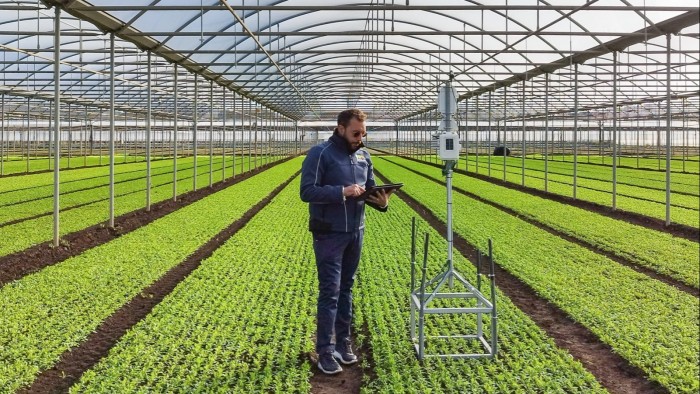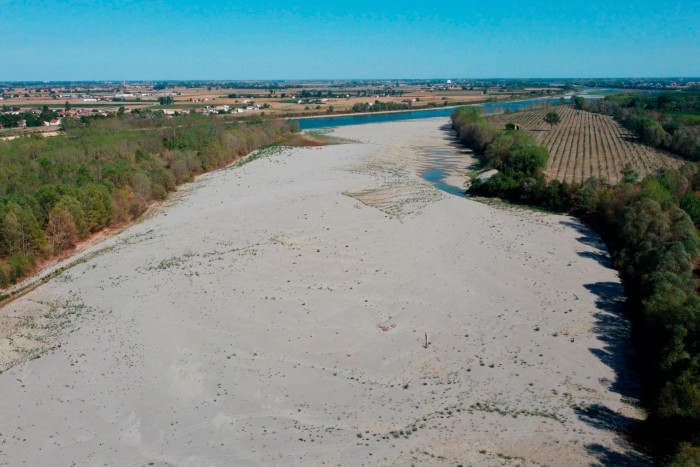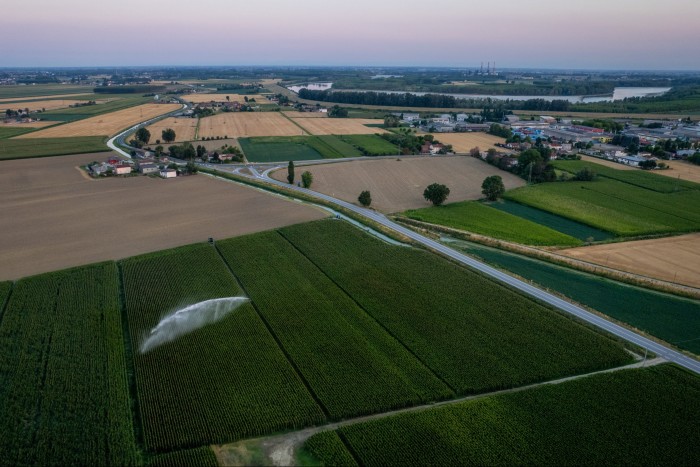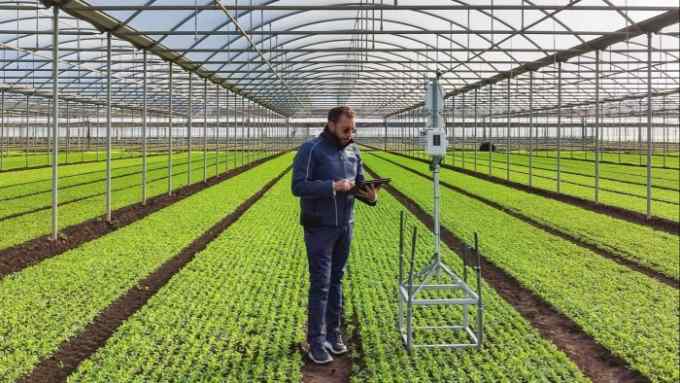Climate change forces Italy’s farmers to focus on water

Roula Khalaf, Editor of the FT, selects her favourite stories in this weekly newsletter.
On an unseasonably hot October morning, biotechnologist Daniele Moscariello heads to a field of newly sprouting rocket (rucola) on his employer’s 100-hectare farm in southern Italy. Once there, he checks his phone for an update on the soil moisture level.
Traditionally, the family-owned Rago Group used about 800 cubic metres of water per hectare per year to irrigate the rocket that it grows, along with other leafy greens such as baby spinach, chard and romaine lettuce, for consumers across Europe and the Middle East.
These days, though, the company is reducing its water usage with a new sensor and data analysis system called Hubfarm, which monitors soil moisture, temperature and humidity levels, and tells growers precisely when, and how much, to irrigate.
This system — developed by the Italian agribusiness association Confagricoltura and now available to its members — has helped the Rago Group cut its annual water use for cultivating rocket by 37 per cent, to about 500 cubic metres per hectare. After experimenting with 10 sensor-based monitoring stations, the company has ordered 50 more.
“The advantage is you can maximise water savings by monitoring the field every day,” says Moscariello, part of the farm’s management team. “We can understand how much water you need at different levels and synchronise the volume of water to the needs of the plant.”
Finding innovative ways to reduce water use — and expand water storage capacity — is an urgent priority for Italy’s vast agribusiness sector, especially after last year’s severe drought. It devastated crops and led to disputes between farmers across the traditionally fertile Po river valley over the distribution of scarce water supplies.
Searing dry years are expected to become more common in Italy — one of the European countries most affected by climate change — because of its long Mediterranean coastline. Already, farmers are complaining of hotter, longer summers, while rains and Alpine snowfall are becoming far more erratic, putting water under mounting pressure.

Italian agribusinesses — which exported food and wine worth €60bn last year, up from €37bn in 2015 — are now looking hard at how to make the country’s public irrigation system and their own farms more resilient.
“Many farmers have understood that water is, and it will be, a problem,” says Massimiliano Giansanti, Confagricoltura’s president. “The rain is not the rain that we knew from the past years.”
According to Confagricoltura, Italy’s public irrigation infrastructure has the capacity to store just 10 or 11 per cent of its annual rainfall. Though Italy built hundreds of large dams in the years after the second world war, poor construction and inadequate maintenance mean many are no longer fully operational.
About 40-50 per cent of irrigation water is lost in transit because of evaporation from the antiquated, open channels or because of cracks in the cement piping. Although none of these infrastructure deficiencies are new, they are being felt ever more acutely in a warming world. “In the past, no one thought about the use of water, because we had a lot of it,” Giansanti says. “People didn’t understand what it means to manage water.”
Rain, when it does come, is often now heavily compressed into short periods. This spring, the fertile Emilia-Romagna region was hit by devastating floods, after receiving the equivalent of half its annual average rainfall in just 36 hours.
But while farming organisations agree that Italy will ultimately need more large-scale water storage facilities to capture rains when they come, such costly public projects could take decades to realise.
For example, Confagricoltura is now working with Italian water companies to prepare a proposal for the government for a new large-scale plant that could treat waste water and make it ready for use in irrigation — a practice common in many countries.
Italy theoretically permits such plants, too. However, in reality, stringent regulations have made it tough for projects to get off the ground, while farmers also remain anxious about such an approach.
“It’s a problem for some farmers — they want to know who guarantees the water,” Giansanti says.
For now, Italy’s €200bn, EU-funded Covid recovery plan has allocated €880mn to upgrade and modernise a third of the country’s irrigation channels by 2026, and to install water meters so farmers pay only for the water they use.

At the same time, Italy’s government is offering farmers tax credits for private investments they make in boosting their farms’ sustainability, including efforts to cut water use.
Encouraged by these incentives, Italian cultivators last year invested €2.1bn in new farm management systems, innovative cultivation techniques, and machinery — up from €300mn on such items in 2018, Giansanti says.
In addition to making investments, many farmers are also looking to develop their own rainwater harvesting systems, after the government — following the drought and lobbying from farmers — pledged to ease the red tape that has previously stifled such initiatives.
Among those hoping to go down this path is Antonio Rago, production director at Rago Group, who says his farm hopes to collect the rainwater that falls on the tarpaulins that protect the fields of delicate rocket leaves from the elements. A small rainwater harvesting system — one that could collect water from 10 hectares — would cost about €30,000, for tubing and digging the storage pond.
Five months after applying for permission for the first trial systems, though, Rago is still waiting for authorisation to proceed.
“I think other farmers will also go in this direction. It’s compulsory — there is no water,” he says. “But if we can recover the rainwater, I think we can survive.”
Climate Capital

Where climate change meets business, markets and politics. Explore the FT’s coverage here.
Are you curious about the FT’s environmental sustainability commitments? Find out more about our science-based targets here

Comments